-
 Mapping the Dynamics of Contemporary PRRSV-2 Evolution and Its Emergence and Spreading Hotspots in the U.S. Using Phylogeography
Mapping the Dynamics of Contemporary PRRSV-2 Evolution and Its Emergence and Spreading Hotspots in the U.S. Using Phylogeography -
 Mechanisms of Innate Immune Sensing of HTLV-1 and Viral Immune Evasion
Mechanisms of Innate Immune Sensing of HTLV-1 and Viral Immune Evasion -
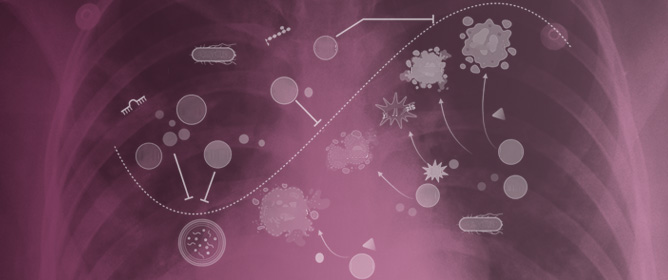 Virulence Factors of Mycobacterium tuberculosis as Modulators of Cell Death Mechanisms
Virulence Factors of Mycobacterium tuberculosis as Modulators of Cell Death Mechanisms -
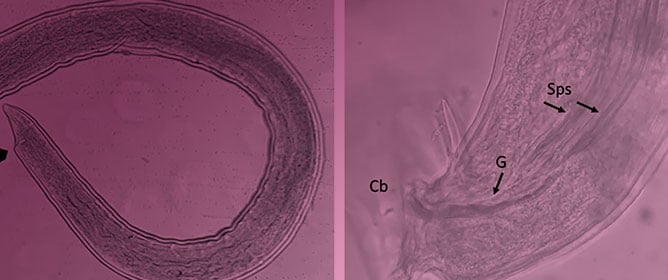 Update on the First Finding of the Rat Lungworm, Angiostrongylus cantonensis, in Rattus spp. in Continental Europe, Valencia, Spain, 2022
Update on the First Finding of the Rat Lungworm, Angiostrongylus cantonensis, in Rattus spp. in Continental Europe, Valencia, Spain, 2022 -
 Recent Insights into the Role of B Cells in Chronic Hepatitis B and C Infections
Recent Insights into the Role of B Cells in Chronic Hepatitis B and C Infections
Journal Description
Pathogens
Pathogens
is an international, peer-reviewed, open access journal of pathogens and pathogen-host interactions published monthly online by MDPI.
- Open Access— free for readers, with article processing charges (APC) paid by authors or their institutions.
- High Visibility: indexed within Scopus, SCIE (Web of Science), PubMed, PMC, Embase, PubAg, CaPlus / SciFinder, AGRIS, and other databases.
- Journal Rank: JCR - Q2 (Microbiology) / CiteScore - Q2 (General Immunology and Microbiology)
- Rapid Publication: manuscripts are peer-reviewed and a first decision is provided to authors approximately 16.4 days after submission; acceptance to publication is undertaken in 2.7 days (median values for papers published in this journal in the first half of 2023).
- Recognition of Reviewers: reviewers who provide timely, thorough peer-review reports receive vouchers entitling them to a discount on the APC of their next publication in any MDPI journal, in appreciation of the work done.
- Companion journals for Pathogens include: Parasitologia, Bacteria and Zoonotic Diseases.
Impact Factor:
3.7 (2022);
5-Year Impact Factor:
3.7 (2022)
Latest Articles
Reshaping Our Knowledge: Advancements in Understanding the Immune Response to Human Respiratory Syncytial Virus
Pathogens 2023, 12(9), 1118; https://doi.org/10.3390/pathogens12091118 (registering DOI) - 01 Sep 2023
Abstract
Human respiratory syncytial virus (hRSV) is a significant cause of respiratory tract infections, particularly in young children and older adults. In this review, we aimed to comprehensively summarize what is known about the immune response to hRSV infection. We described the innate and
[...] Read more.
Human respiratory syncytial virus (hRSV) is a significant cause of respiratory tract infections, particularly in young children and older adults. In this review, we aimed to comprehensively summarize what is known about the immune response to hRSV infection. We described the innate and adaptive immune components involved, including the recognition of RSV, the inflammatory response, the role of natural killer (NK) cells, antigen presentation, T cell response, and antibody production. Understanding the complex immune response to hRSV infection is crucial for developing effective interventions against this significant respiratory pathogen. Further investigations into the immune memory generated by hRSV infection and the development of strategies to enhance immune responses may hold promise for the prevention and management of hRSV-associated diseases.
Full article
(This article belongs to the Special Issue Immunity to Respiratory Infections)
►
Show Figures
Open AccessReview
Rabbits as Animal Models for Anti-Tick Vaccine Development: A Global Scenario
by
, , , and
Pathogens 2023, 12(9), 1117; https://doi.org/10.3390/pathogens12091117 (registering DOI) - 01 Sep 2023
Abstract
Studies evaluating candidate tick-derived proteins as anti-tick vaccines in natural hosts have been limited due to high costs. To overcome this problem, animal models are used in immunization tests. The aim of this article was to review the use of rabbits as an
[...] Read more.
Studies evaluating candidate tick-derived proteins as anti-tick vaccines in natural hosts have been limited due to high costs. To overcome this problem, animal models are used in immunization tests. The aim of this article was to review the use of rabbits as an experimental model for the evaluation of tick-derived proteins as vaccines. A total of 57 tick proteins were tested for their immunogenic potential using rabbits as models for vaccination. The most commonly used rabbit breeds were New Zealand (73.8%), Japanese white (19%), Californians (4.8%) and Flemish lop-eared (2.4%) rabbits. Anti-tick vaccines efficacy resulted in up to 99.9%. Haemaphysalis longicornis (17.9%) and Ornithodoros moubata (12.8%) were the most common tick models in vaccination trials. Experiments with rabbits have revealed that some proteins (CoAQP, OeAQP, OeAQP1, Bm86, GST-Hl, 64TRP, serpins and voraxin) can induce immune responses against various tick species. In addition, in some cases it was possible to determine that the vaccine efficacy in rabbits was similar to that of experiments performed on natural hosts (e.g., Bm86, IrFER2, RmFER2, serpins and serine protease inhibitor). In conclusion, results showed that prior to performing anti-tick vaccination trials using natural hosts, rabbits can be used as suitable experimental models for these studies.
Full article
(This article belongs to the Collection Advances in Tick Research)
►▼
Show Figures
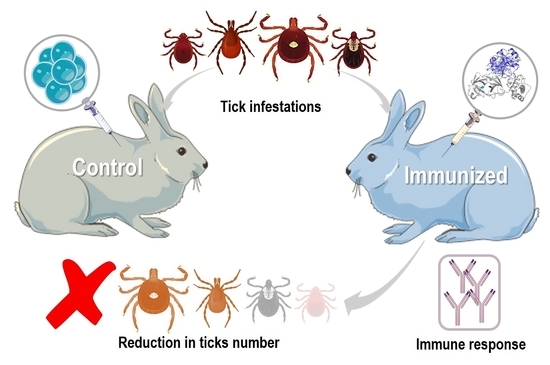
Graphical abstract
Open AccessArticle
Can sPD-1 and sPD-L1 Plasma Concentrations Predict Treatment Response among Patients with Extraparenchymal Neurocysticercosis?
by
, , , , and
Pathogens 2023, 12(9), 1116; https://doi.org/10.3390/pathogens12091116 (registering DOI) - 01 Sep 2023
Abstract
Extraparenchymal neurocysticercosis (EP-NC) is a chronic, potentially life-threatening disease that responds poorly to initial anthelmintic drug therapy. A depressed specific reactivity of peripheral lymphocytes and an increased level of specific Tregs accompanies EP-NC. The immune checkpoint pathway PD-1 and its ligand PD-L1 downregulates
[...] Read more.
Extraparenchymal neurocysticercosis (EP-NC) is a chronic, potentially life-threatening disease that responds poorly to initial anthelmintic drug therapy. A depressed specific reactivity of peripheral lymphocytes and an increased level of specific Tregs accompanies EP-NC. The immune checkpoint pathway PD-1 and its ligand PD-L1 downregulates effector T cells, causing specific immune suppression in chronic diseases. This study explored whether their soluble forms, sPD-1/sPD-L1, are present in plasma among patients with EP-NC and if their levels could be associated with treatment response. A total of 21 patients with vesicular EP-NC and 22 healthy controls were included. Patients received standard treatment and were followed for six months to assess treatment response by assessing changes in cyst volume determined with 3D MRI. The presence of both sPD-1 and sPD-L1 was more frequently detected among patients with EP-NC than in healthy controls and had higher concentrations. Among patients, higher pre-treatment levels of both markers were associated with a poor treatment response, and the sensitivity and specificity of the sPD-1/sPD-L1 ratio for predicting any response to treatment were high. Our results are consistent with the presence of lymphocyte exhaustion and open new research perspectives to improve the prognosis of patients with this severe disease.
Full article
(This article belongs to the Special Issue Recent Advances in Taeniasis and Cysticercosis)
►▼
Show Figures
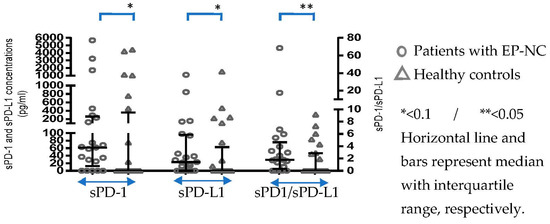
Figure 1
Open AccessArticle
A New Sturgeon Herpesvirus from Juvenile Lake Sturgeon Acipenser fulvescens Displaying Epithelial Skin Lesions
by
, , , , , , , and
Pathogens 2023, 12(9), 1115; https://doi.org/10.3390/pathogens12091115 - 31 Aug 2023
Abstract
Herpesvirus infections of sturgeon pose a potential threat to sturgeon culture efforts worldwide. A new epitheliotropic herpesvirus named Acipenser herpesvirus 3 (AciHV-3) was detected in hatchery-reared Lake Sturgeon Acipenser fulvescens displaying skin lesions in central Canada. The growths were discovered in the fall,
[...] Read more.
Herpesvirus infections of sturgeon pose a potential threat to sturgeon culture efforts worldwide. A new epitheliotropic herpesvirus named Acipenser herpesvirus 3 (AciHV-3) was detected in hatchery-reared Lake Sturgeon Acipenser fulvescens displaying skin lesions in central Canada. The growths were discovered in the fall, reached average prevalence levels of 0.2–40% and eventually regressed. No unusual mortality was observed. The cellular changes within the lesions included epithelial hyperplasia and were reminiscent of other herpesvirus infections. The virus was not evident in lesions examined by electron microscopy. Skin tissue homogenates from symptomatic sturgeon produced atypical cytopathic effects on a primary Lake Sturgeon cell line, and next-generation sequence analysis of the DNA samples revealed the presence of an alloherpesvirus. A new genotyping PCR assay targeting the major capsid protein sequence detected AciHV-3 in symptomatic Lake Sturgeon as well as other apparently healthy sturgeon species. Bayesian inference of phylogeny reconstructed with a concatenation of five alloherpesvirus core proteins revealed a new Alloherpesviridae lineage isomorphic with a new genus. The presence of AciHV-3 homologs in cell lines and sturgeon sequence datasets, low sequence divergence among these homologs and branching patterns within the genotyping phylogeny provide preliminary evidence of an endogenous virus lifestyle established in an ancestral sturgeon.
Full article
(This article belongs to the Special Issue Emerging Infections in Aquatic Animals)
►▼
Show Figures
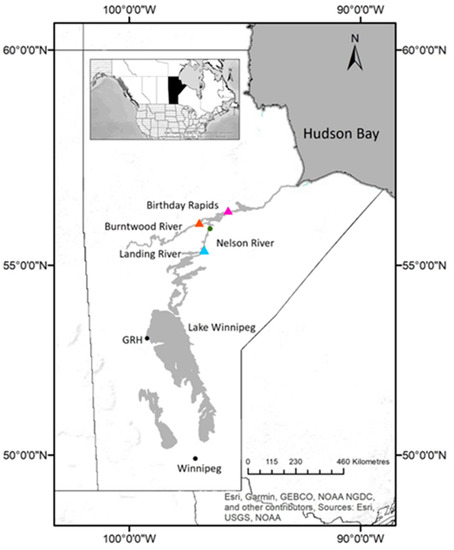
Figure 1
Open AccessArticle
Ammonia and Nematode Ascaroside Are Synergistic in Trap Formation in Arthrobotrys oligospora
Pathogens 2023, 12(9), 1114; https://doi.org/10.3390/pathogens12091114 - 31 Aug 2023
Abstract
Nematode-trapping (NT) fungi are natural predators of the soil living nematodes. Diverse external signals mediate the generation of predatory devices of NT fungi. Among these, broad ascarosides and nitrogenous ammonia are highly efficient inducers for trap structure initiation. However, the overlay effect of
[...] Read more.
Nematode-trapping (NT) fungi are natural predators of the soil living nematodes. Diverse external signals mediate the generation of predatory devices of NT fungi. Among these, broad ascarosides and nitrogenous ammonia are highly efficient inducers for trap structure initiation. However, the overlay effect of ammonia and ascaroside on the trap morphogenesis remains unclear. This study demonstrated that the combination of nitrogenous substances with nematode-derived ascarosides led to higher trap production compared to the single inducing cues; notably, ammonia and Ascr#18 had the most synergistic effect on the trap in A. oligospora. Further, the deletion of ammonia transceptor Amt43 blocked trap formation against ammonia addition in A. oligospora but not for the ascaroside Ascr#18 induction. Moreover, ammonia addition could promote plasma endocytosis in the process of trap formation. In contrast, ascaroside addition would facilitate the stability of intracellular organization away from endocytosis. Therefore, there is a synergistic effect on trap induction from different nitrogenous and ascaroside signals.
Full article
(This article belongs to the Special Issue Nematophagous Fungi)
►▼
Show Figures
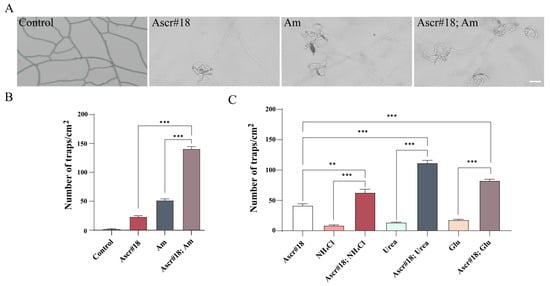
Figure 1
Open AccessArticle
Plasma Blood Levels of Tafenoquine following a Single Oral Dosage in BALBc Mice with Acute Babesia microti Infection That Resulted in Rapid Clearance of Microscopically Detectable Parasitemia
by
, , , , , and
Pathogens 2023, 12(9), 1113; https://doi.org/10.3390/pathogens12091113 - 31 Aug 2023
Abstract
Previous studies of mice infected with Babesia microti have shown that a single dose of tafenoquine administered orally is extremely effective at decreasing microscopically detectable parasitemia. However, a critical limitation of studies to date is the lack of data concerning the plasma levels
[...] Read more.
Previous studies of mice infected with Babesia microti have shown that a single dose of tafenoquine administered orally is extremely effective at decreasing microscopically detectable parasitemia. However, a critical limitation of studies to date is the lack of data concerning the plasma levels of tafenoquine that are needed to treat babesiosis. In the current study, we begin to address this gap by examining the plasma levels of tafenoquine associated with the rapid reduction of B. microti patent parasitemia in a mouse model of babesiosis. In the current study, we infected BALB/c mice with 1 × 107 B. microti-infected red blood cells. Two days post-infection, mice were treated with 20 mg/kg of tafenoquine succinate or vehicle control administered orally by gavage. Parasitemia and plasma levels of tafenoquine were evaluated every 24 h post-treatment for 96 h. This allowed us to correlate blood plasma levels of tafenoquine with reductions in parasitemia in treated mice. Consistent with previous studies, a single oral dose of 20 mg/kg tafenoquine resulted in a rapid reduction in parasitemia. Plasma levels of tafenoquine 24 h post-administration ranged from 347 to 503 ng/mL and declined thereafter. This blood plasma tafenoquine level is similar to that achieved in humans using the current FDA-approved dose for the prevention of malaria. Thus, our study shows that the plasma levels of tafenoquine associated with parasite clearance in this mouse model at 24 h post-administration are clearly achievable in humans receiving the tafenoquine dosing used to prevent malaria, a dosage regimen found to have an excellent and well-studied safety profile.
Full article
(This article belongs to the Special Issue Pathogenesis, Epidemiology, Host Response and Control of Lyme Disease and Other Tick-Borne Diseases)
►▼
Show Figures
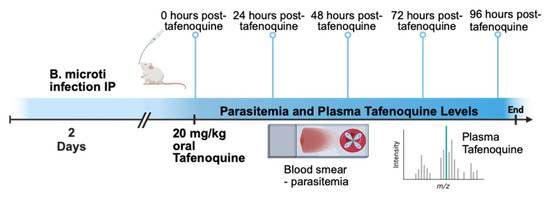
Figure 1
Open AccessCase Report
A Fatal Case of Disseminated Histoplasmosis by Histoplasma capsulatum var. capsulatum Misdiagnosed as Visceral Leishmaniasis—Molecular Diagnosis and Identification
Pathogens 2023, 12(9), 1112; https://doi.org/10.3390/pathogens12091112 - 30 Aug 2023
Abstract
Histoplasmosis is an endemic mycosis in the Americas. However, its diagnosis is challenging due to the complexity and limited availability of conventional laboratory techniques—antigen tests, culture, and staining. Microscopic preparations often confuse with other pathogens, such as Leishmania spp. The genus Histoplasma capsulatum comprises
[...] Read more.
Histoplasmosis is an endemic mycosis in the Americas. However, its diagnosis is challenging due to the complexity and limited availability of conventional laboratory techniques—antigen tests, culture, and staining. Microscopic preparations often confuse with other pathogens, such as Leishmania spp. The genus Histoplasma capsulatum comprises three varieties: var. capsulatum, var. duboissi, and var. farciminosum, which cannot be distinguished using conventional techniques. An infant from a tropical region of Ecuador was hospitalized for fever, bloody diarrhea, and anemia persisting for two months. Upon admission, he received antibiotics and immunosuppressants. Histopathological examination of the lymph nodes, intestines, and bone marrow aspirate reported the presence of Leishmania-like amastigotes, and treatment was initiated with meglumine antimoniate and conventional amphotericin B. However, subsequent analysis of samples using PCR and DNA sequencing identified H. capsulatum var. capsulatum but not Leishmania. Despite fluconazole and amphotericin B, the infant succumbed to the disease. The delay in clinical and laboratory diagnosis of histoplasmosis and the use of nonspecific and ineffective drugs such as fluconazole led to disease dissemination and, ultimately, death. Implementing molecular diagnosis and antigen tests in laboratories located in endemic regions and reference hospitals is crucial.
Full article
(This article belongs to the Section Fungal Pathogens)
►▼
Show Figures
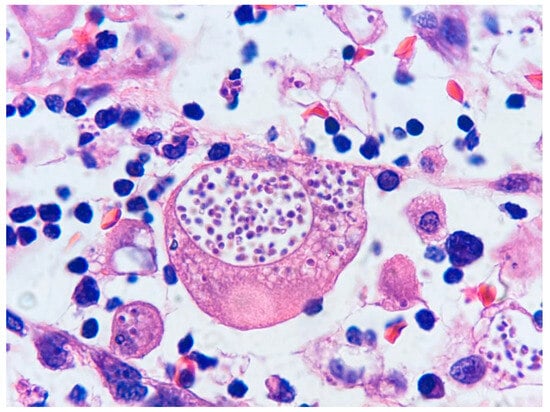
Figure 1
Open AccessEditorial
Flu on the Brain: Identification of Highly Pathogenic Influenza in the Brains of Wild Carnivores in The Netherlands
Pathogens 2023, 12(9), 1111; https://doi.org/10.3390/pathogens12091111 - 30 Aug 2023
Abstract
Highly pathogenic avian influenza (HPAI) viruses circulate in wild birds and can infect domestic poultry [...]
Full article
Open AccessReview
Periodontopathogens Porphyromonas gingivalis and Fusobacterium nucleatum and Their Roles in the Progression of Respiratory Diseases
Pathogens 2023, 12(9), 1110; https://doi.org/10.3390/pathogens12091110 - 30 Aug 2023
Abstract
The intricate interplay between oral microbiota and the human host extends beyond the confines of the oral cavity, profoundly impacting the general health status. Both periodontal diseases and respiratory diseases show high prevalence worldwide and have a marked influence on the quality of
[...] Read more.
The intricate interplay between oral microbiota and the human host extends beyond the confines of the oral cavity, profoundly impacting the general health status. Both periodontal diseases and respiratory diseases show high prevalence worldwide and have a marked influence on the quality of life for the patients. Accumulating studies are establishing a compelling association between periodontal diseases and respiratory diseases. Here, in this review, we specifically focus on the key periodontal pathogenic bacteria Porphyromonas gingivalis and Fusobacterium nucleatum and dissect their roles in the onset and course of respiratory diseases, mainly pneumonia, chronic obstructive pulmonary disease, lung cancer, and asthma. The mechanistic underpinnings and molecular processes on how P. gingivalis and F. nucleatum contribute to the progression of related respiratory diseases are further summarized and analyzed, including: induction of mucus hypersecretion and chronic airway inflammation; cytotoxic effects to disrupt the morphology and function of respiratory epithelial cells; synergistic pathogenic effects with respiratory pathogens like Streptococcus pneumoniae and Pseudomonas aeruginosa. By delving into the complex relationship to periodontal diseases and periodontopathogens, this review helps unearth novel insights into the etiopathogenesis of respiratory diseases and inspires the development of potential therapeutic avenues and preventive strategies.
Full article
(This article belongs to the Special Issue Insights in Oral Microbiota)
►▼
Show Figures
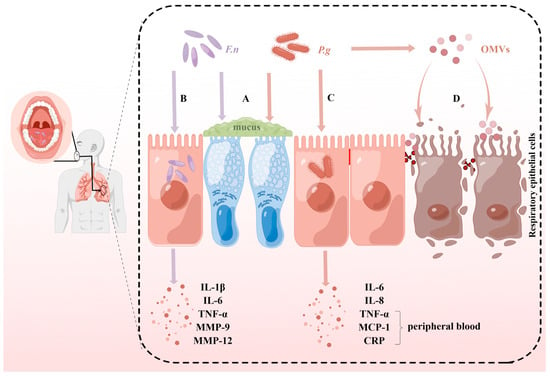
Figure 1
Open AccessArticle
Mycobacterium tuberculosis Central Metabolism Is Key Regulator of Macrophage Pyroptosis and Host Immunity
by
, , , , and
Pathogens 2023, 12(9), 1109; https://doi.org/10.3390/pathogens12091109 - 30 Aug 2023
Abstract
Metabolic dysregulation in Mycobacterium tuberculosis results in increased macrophage apoptosis or pyroptosis. However, mechanistic links between Mycobacterium virulence and bacterial metabolic plasticity remain ill defined. In this study, we screened random transposon insertions of M. bovis BCG to identify mutants that induce pyroptotic
[...] Read more.
Metabolic dysregulation in Mycobacterium tuberculosis results in increased macrophage apoptosis or pyroptosis. However, mechanistic links between Mycobacterium virulence and bacterial metabolic plasticity remain ill defined. In this study, we screened random transposon insertions of M. bovis BCG to identify mutants that induce pyroptotic death of the infected macrophage. Analysis of the transposon insertion sites identified a panel of fdr (functioning death repressor) genes, which were shown in some cases to encode functions central to Mycobacterium metabolism. In-depth studies of one fdr gene, fdr8 (BCG3787/Rv3727), demonstrated its important role in the maintenance of M. tuberculosis and M. bovis BCG redox balance in reductive stress conditions in the host. Our studies expand the subset of known Mycobacterium genes linking bacterial metabolic plasticity to virulence and also reveal that the broad induction of pyroptosis by an intracellular bacterial pathogen is linked to enhanced cellular immunity in vivo.
Full article
(This article belongs to the Special Issue Biology of Mycobacterial Pathogens)
►▼
Show Figures
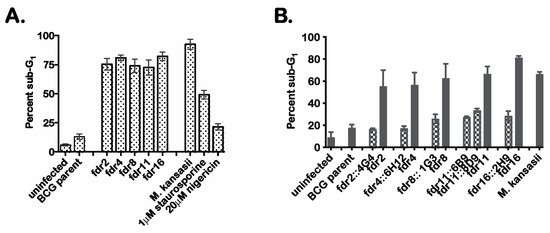
Figure 1
Open AccessArticle
In Vitro Antibody-Dependent Enhancement of SARS-CoV-2 Infection Could Be Abolished by Adding Human IgG
by
, , , , , , , , , , and
Pathogens 2023, 12(9), 1108; https://doi.org/10.3390/pathogens12091108 - 30 Aug 2023
Abstract
Evidence of antibody-dependent enhancement (ADE) of other viruses has raised concerns about the safety of SARS-CoV-2 vaccines and antibody therapeutics. In vitro studies have shown ADE of SARS-CoV-2 infection. In this study, we also found that vaccination/convalescent sera and some approved monoclonal antibodies
[...] Read more.
Evidence of antibody-dependent enhancement (ADE) of other viruses has raised concerns about the safety of SARS-CoV-2 vaccines and antibody therapeutics. In vitro studies have shown ADE of SARS-CoV-2 infection. In this study, we also found that vaccination/convalescent sera and some approved monoclonal antibodies can enhance SARS-CoV-2 infection of FcR-expressing B cells in vitro. However, the enhancement of SARS-CoV-2 infection can be prevented by blocking Fc–FcR interaction through the addition of human serum/IgG or the introduction of mutations in the Fc portion of the antibody. It should be noted that ADE activity observed on FcR-expressing cells in vitro may not necessarily reflect the situation in vivo; therefore, animal and clinical data should be included for ADE evaluation.
Full article
(This article belongs to the Topic Host Response against SARS-CoV-2 Infection: Implications for Diagnosis, Treatment and Vaccine Development)
►▼
Show Figures
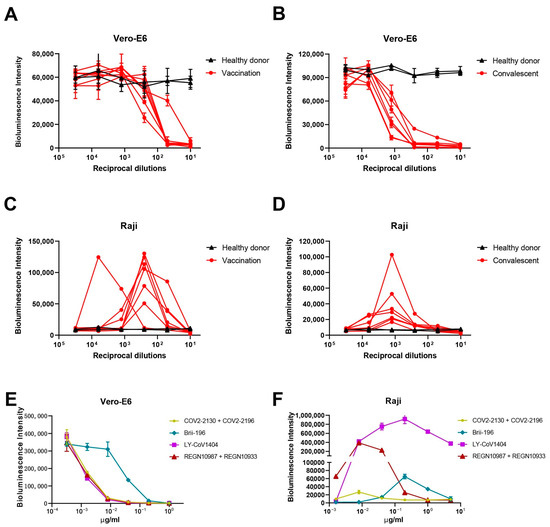
Figure 1
Open AccessEditorial
Advances in the Control of the Helminthosis in Domestic Animals
Pathogens 2023, 12(9), 1107; https://doi.org/10.3390/pathogens12091107 - 30 Aug 2023
Abstract
The damage caused by parasitic worms is related to delays in production, the cost of prophylactic and curative treatments and, in extreme cases, the death of animals [...]
Full article
(This article belongs to the Special Issue Advances in the Control of the Helminthosis in Domestic Animals)
Open AccessArticle
Evaluating Trends in Strangles Outbreaks Using Temperature and Precipitation Data in the United States of America for 2018–2022
Pathogens 2023, 12(9), 1106; https://doi.org/10.3390/pathogens12091106 - 29 Aug 2023
Abstract
Strangles is a highly contagious upper respiratory infection of equids that is globally distributed. The causative agent of strangles, Streptococcus equi subspecies equi, can be spread through indirect contact with infected fomites, and studies have shown this microbe to live well in
[...] Read more.
Strangles is a highly contagious upper respiratory infection of equids that is globally distributed. The causative agent of strangles, Streptococcus equi subspecies equi, can be spread through indirect contact with infected fomites, and studies have shown this microbe to live well in varying environmental conditions. The purpose of this study was to analyze strangles case numbers across the United States of America from 2018 to 2022 to investigate potential temporal or weather patterns associated with outbreaks. Diagnosed case records were obtained from the Equine Disease Communication Center, university databases, government agencies, or veterinary diagnostic labs, and geographic information systems (GISs) were used to map cases and to acquire relevant meteorological data from outbreak areas. These data were analyzed using logistic regression to explore trends that occur between outbreaks and changes in temperature and precipitation. Initial review of weather data suggested monthly changes in strangles case numbers corresponded with changing seasons. Logistic regression indicated that changes in monthly average temperature and minimum temperature were significantly associated with increased or decreased odds of strangles outbreaks, respectively. Future analyses should focus on weather data isolated within a smaller region or state to better resolve trends in strangles outbreaks throughout the continental USA.
Full article
(This article belongs to the Special Issue Spatio-Temporal Analysis of Veterinary Infectious Diseases)
Open AccessCommunication
Regional Differences in Intestinal Parasitic Infections among Army Recruits in a Southern Mozambique Training Center: A Cross-Sectional Study
Pathogens 2023, 12(9), 1105; https://doi.org/10.3390/pathogens12091105 - 29 Aug 2023
Abstract
Due to the high prevalence and diversity of clinical manifestations, intestinal parasitic infections (IPIs) represent a public health problem. The objective of the work was to determine the prevalence of IPIs among army recruits at a practice and training center in southern Mozambique.
[...] Read more.
Due to the high prevalence and diversity of clinical manifestations, intestinal parasitic infections (IPIs) represent a public health problem. The objective of the work was to determine the prevalence of IPIs among army recruits at a practice and training center in southern Mozambique. Sociodemographic information was obtained through semi-structured interviews. Single urine and stool samples were collected from 362 recruits. Parasite diagnosis was made by filtration, formaldehyde-ether and Kato-Katz techniques. Positive individuals underwent abdominal ultrasound. Then, descriptive statistics and cross-tabulations were performed, and p-values < 0.05 were considered significant. The prevalence of infection with at least one parasite was 25.1% (95% CI: 20.5–29.6; n = 91). The most common parasites were Entamoeba coli (10.7%; 95% CI: 7.4–13.7; n = 37) and Trichuris trichiura (6.1%; 95% CI: 4.6–9.9; n = 25). Parasitic infection was associated with the origin of the participant (p-value < 0.001), and the province of Sofala had the highest prevalence among the provinces studied (70.6%; 95% CI: 47.0–87.8; 12/17). Since oral fecal transmission occurs for several parasites, routine screening and deworming prior to enrollment at the army training center is recommended to reduce transmission of intestinal parasites among recruits.
Full article
(This article belongs to the Special Issue Intestinal Parasites Infection)
►▼
Show Figures
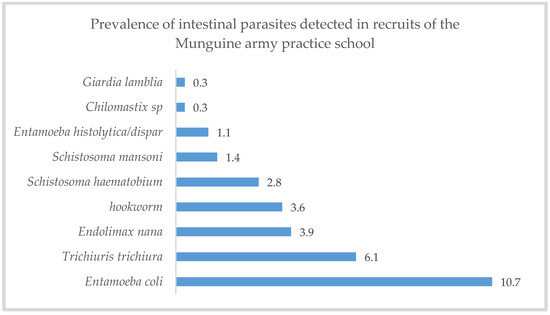
Figure 1
Open AccessArticle
Viability of Veterinary-Relevant Viruses in Decomposing Tissues over a 90-Day Period Using an In-Vitro System
by
, , , and
Pathogens 2023, 12(9), 1104; https://doi.org/10.3390/pathogens12091104 - 29 Aug 2023
Abstract
►▼
Show Figures
Depopulation is frequently employed during outbreaks of high-impact animal diseases. Security breaches in sites managing mortality may jeopardize pathogen control efforts as infected carcasses can serve as an infection source. This study evaluated the viability and nucleic acid detection of veterinary-relevant viruses or
[...] Read more.
Depopulation is frequently employed during outbreaks of high-impact animal diseases. Security breaches in sites managing mortality may jeopardize pathogen control efforts as infected carcasses can serve as an infection source. This study evaluated the viability and nucleic acid detection of veterinary-relevant viruses or their surrogates in decomposing tissues. The used viruses were: Senecavirus A1 (SVA), feline calicivirus (FCV), bovine viral diarrhea virus (BVDV), porcine epidemic diarrhea virus (PEDV), bovine alphaherpesvirus 1 (BoHV-1), and swinepox virus (SwPV). Viruses were spiked in three decomposing tissues (swine bone marrow and spleen, and bovine bone marrow) and maintained for 90 days. Samples were kept under two temperature conditions resembling the average soil temperature in central Oklahoma, US, during the winter and summer (5.5 °C and 29.4 °C). At 5.5 °C, SVA and FCV remained viable over the 90 days of the study, followed by BVDV (75 days), BoHV-1 and SwPV (60 days), and PEDV (10 days). At 29.4 °C, SVA remained viable for 45 days, followed by BVDV and BoHV-1 (14 days). SwPV was viable for 10 days, whereas FCV and PEDV were viable for 5 days. Overall, viral nucleic acid detection was not significantly altered during the study. These findings support decision-making and risk management in sites overseeing animal mortality.
Full article

Figure 1
Open AccessArticle
Monocytes from Uninfected Neonates Born to Trypanosoma cruzi-Infected Mothers Display Upregulated Capacity to Produce TNF-α and to Control Infection in Association with Maternally Transferred Antibodies
by
, , , , , , and
Pathogens 2023, 12(9), 1103; https://doi.org/10.3390/pathogens12091103 - 29 Aug 2023
Abstract
Activated monocytes/macrophages that produce inflammatory cytokines and nitric oxide are crucial for controlling Trypanosoma cruzi infection. We previously showed that uninfected newborns from T. cruzi infected mothers (M+B- newborns) were sensitized to produce higher levels of inflammatory cytokines than newborns from uninfected mothers
[...] Read more.
Activated monocytes/macrophages that produce inflammatory cytokines and nitric oxide are crucial for controlling Trypanosoma cruzi infection. We previously showed that uninfected newborns from T. cruzi infected mothers (M+B- newborns) were sensitized to produce higher levels of inflammatory cytokines than newborns from uninfected mothers (M-B- newborns), suggesting that their monocytes were more activated. Thus, we wondered whether these cells might help limit congenital infection. We investigated this possibility by studying the activation status of M+B- cord blood monocytes and their ability to control T. cruzi in vitro infection. We showed that M+B- monocytes have an upregulated capacity to produce the inflammatory cytokine TNF-α and a better ability to control T. cruzi infection than M-B- monocytes. Our study also showed that T. cruzi-specific Abs transferred from the mother play a dual role by favoring trypomastigote entry into M+B- monocytes and inhibiting intracellular amastigote multiplication. These results support the possibility that some M+B- fetuses may eliminate the parasite transmitted in utero from their mothers, thus being uninfected at birth.
Full article
(This article belongs to the Special Issue Current Research on Trypanosoma cruzi Infection 2023)
►▼
Show Figures
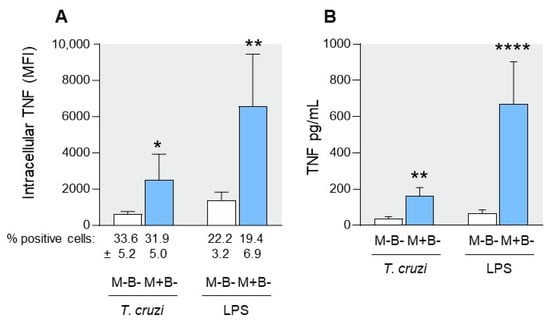
Figure 1
Open AccessArticle
Evaluation of Wild Peanut Species and Their Allotetraploids for Resistance against Thrips and Thrips-Transmitted Tomato Spotted Wilt Orthotospovirus (TSWV)
by
, , , , , , , and
Pathogens 2023, 12(9), 1102; https://doi.org/10.3390/pathogens12091102 - 28 Aug 2023
Abstract
Thrips-transmitted tomato spotted wilt orthotospovirus (TSWV) causes spotted wilt disease in peanut (Arachis hypogaea L.) and limits yield. Breeding programs have been developing TSWV-resistant cultivars, but availability of sources of resistance against TSWV in cultivated germplasm is extremely limited. Diploid wild Arachis
[...] Read more.
Thrips-transmitted tomato spotted wilt orthotospovirus (TSWV) causes spotted wilt disease in peanut (Arachis hypogaea L.) and limits yield. Breeding programs have been developing TSWV-resistant cultivars, but availability of sources of resistance against TSWV in cultivated germplasm is extremely limited. Diploid wild Arachis species can serve as important sources of resistance, and despite ploidy barriers (cultivated peanut is tetraploid), their usage in breeding programs is now possible because of the knowledge and development of induced interspecific allotetraploid hybrids. This study screened 10 wild diploid Arachis and six induced allotetraploid genotypes via thrips-mediated TSWV transmission assays and thrips’ feeding assays in the greenhouse. Three parameters were evaluated: percent TSWV infection, virus accumulation, and temporal severity of thrips feeding injury. Results indicated that the diploid A. stenosperma accession V10309 and its derivative-induced allotetraploid ValSten1 had the lowest TSWV infection incidences among the evaluated genotypes. Allotetraploid BatDur1 had the lowest thrips-inflicted damage at each week post thrips release, while diploid A. batizocoi accession K9484 and A. duranensis accession V14167 had reduced feeding damage one week post thrips release, and diploids A. valida accession GK30011 and A. batizocoi had reduced feeding damage three weeks post thrips releasethan the others. Overall, plausible TSWV resistance in diploid species and their allotetraploid hybrids was characterized by reduced percent TSWV infection, virus accumulation, and feeding severity. Furthermore, a few diploids and tetraploid hybrids displayed antibiosis against thrips. These results document evidence for resistance against TSWV and thrips in wild diploid Arachis species and peanut-compatible-induced allotetraploids.
Full article
(This article belongs to the Special Issue Emerging and Re-emerging Plant Viruses in a Context of Global Change)
►▼
Show Figures
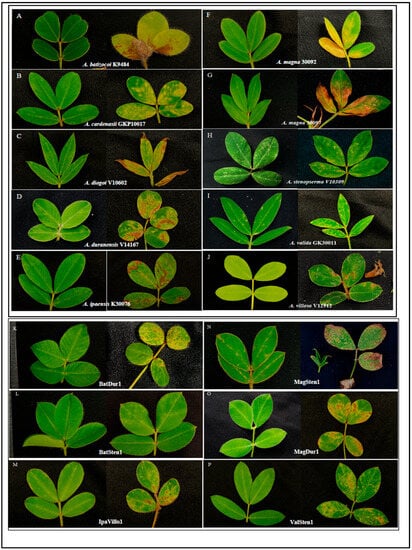
Figure 1
Open AccessArticle
Resistance Profiles and Virulence Determinants in Biofilm-Forming Enterococcus faecium Isolated from Raw Seafood in Bangladesh
by
, , , , , , and
Pathogens 2023, 12(9), 1101; https://doi.org/10.3390/pathogens12091101 - 28 Aug 2023
Abstract
Pathogenic, antibiotic-resistant, and biofilm-forming bacteria can be transferred to humans through the consumption of contaminated seafood. The present study was carried out to determine antibiotic resistance profiles and virulence determinants in biofilm-forming Enterococcus faecium isolated from seafood in Bangladesh. A total of 150
[...] Read more.
Pathogenic, antibiotic-resistant, and biofilm-forming bacteria can be transferred to humans through the consumption of contaminated seafood. The present study was carried out to determine antibiotic resistance profiles and virulence determinants in biofilm-forming Enterococcus faecium isolated from seafood in Bangladesh. A total of 150 seafood samples, including shrimp (n = 50), crabs (n = 25), and marine fish (n = 75), were screened using cultural, staining, biochemical, polymerase chain reaction (PCR), Congo red (CR), and disk diffusion (DD) assays. In PCR, E. faecium was detected in 27.3% (41/150; CI95% 20.8; 34.9) of samples, where marine fish (34.7%, CI95% 24.9; 45.9) had the highest prevalence (p < 0.05) compared to crabs (32%, CI95% 17.2; 51.6) and shrimp (14%, CI95% 7.0; 26.1). Thirty-two (78.1%, CI95% 63.3; 88.0) of the E. faecium isolates were determined to be biofilm formers in the CR test, where 43.9% (18/41, CI95% 29.9; 59.0) and 34.2% (14/41, CI95% 21.6; 49.5) of the isolates were strong and intermediate biofilm formers, respectively. In PCR, virulence genes, i.e., pil (100%), ace (92.7%), agg (68.3%), fsrA (65.9%), gelE (63.4%), sprE (53.7%), fsrB (51.2%), and fsrC (43.9%), were detected in E. faecium isolates. All the E. faecium isolates were phenotypically resistant to ≥3 antimicrobial categories and ≥3 antibiotics, including WHO-classified reserve antibiotics linezolid (70.7%) and fosfomycin (19.5%). Moreover, the multiple antibiotic resistance index ranged up to 0.8, showing resistance to ten antibiotics and eight antibiotic classes. In this study, the prevalence of virulence genes and antibiotic resistance was significantly greater (p < 0.05) in strong biofilm-forming E. faecium strains as compared to strains with intermediate and non-biofilm-forming abilities. As far as we know, this study, for the first time in Bangladesh, determined antibiotic resistance and detected virulence genes in biofilm-forming E. faecium isolated from seafood samples. The data from this study could play a significant role in evaluating potential health hazards linked to the ingestion of uncooked or minimally processed seafood.
Full article
(This article belongs to the Special Issue Surveillance and Control of Foodborne Pathogens)
►▼
Show Figures

Figure 1
Open AccessArticle
Identification and Molecular Characterization of Shamonda Virus in an Aborted Goat Fetus in South Africa
by
, , , , , , , and
Pathogens 2023, 12(9), 1100; https://doi.org/10.3390/pathogens12091100 - 28 Aug 2023
Abstract
Viruses in the Orthobunyavirus genus, Peribunyaviridae family, are associated with encephalitis, birth defects and fatalities in animals, and some are zoonotic. Molecular diagnostic investigations of animals with neurological signs previously identified Shuni virus (SHUV) as the most significant orthobunyavirus in South Africa (SA).
[...] Read more.
Viruses in the Orthobunyavirus genus, Peribunyaviridae family, are associated with encephalitis, birth defects and fatalities in animals, and some are zoonotic. Molecular diagnostic investigations of animals with neurological signs previously identified Shuni virus (SHUV) as the most significant orthobunyavirus in South Africa (SA). To determine if other orthobunyaviruses occur in SA, we screened clinical specimens from animals with neurological signs, abortions, and acute deaths from across SA in 2021 using a small (S) segment Simbu serogroup specific TaqMan real-time reverse transcription polymerase chain reaction (RT-PCR). Positive cases were subjected to Sanger sequencing and phylogenetic analysis to identify specific viruses involved, followed by next-generation sequencing (NGS) and additional PCR assays targeting the medium (M) segment and the large (L) segment. In total, 3/172 (1.7%) animals were PCR positive for Simbu serogroup viruses, including two horses with neurological signs and one aborted goat fetus in 2021. Phylogenetic analyses confirmed that the two horses were infected with SHUV strains with nucleotide pairwise (p-) distances of 98.1% and 97.6% to previously identified strains, while the aborted goat fetus was infected with a virus closely related to Shamonda virus (SHAV) with nucleotide p-distances between 94.7% and 91.8%. Virus isolation was unsuccessful, likely due to low levels of infectious particles. However, phylogenetic analyses of a larger fragment of the S segment obtained through NGS and partial sequences of the M and L segments obtained through RT-PCR and Sanger sequencing confirmed that the virus is likely SHAV with nucleotide p-distances between 96.6% and 97.8%. This is the first detection of SHAV in an aborted animal in SA and suggests that SHAV should be considered in differential diagnosis for abortion in animals in Southern Africa.
Full article
(This article belongs to the Special Issue Molecular Detection and Characterisation of Viral Pathogens)
►▼
Show Figures

Figure 1
Open AccessArticle
Molecular Epidemiology and Genetic Diversity of Human Respiratory Syncytial Virus in Sicily during Pre- and Post-COVID-19 Surveillance Seasons
by
, , , , , , , and
Pathogens 2023, 12(9), 1099; https://doi.org/10.3390/pathogens12091099 - 28 Aug 2023
Abstract
Human respiratory syncytial virus (hRSV) is an important pathogen of acute respiratory tract infection of global significance. In this study, we investigated the molecular epidemiology and the genetic variability of hRSV over seven surveillance seasons between 2015 and 2023 in Sicily, Italy. hRSV
[...] Read more.
Human respiratory syncytial virus (hRSV) is an important pathogen of acute respiratory tract infection of global significance. In this study, we investigated the molecular epidemiology and the genetic variability of hRSV over seven surveillance seasons between 2015 and 2023 in Sicily, Italy. hRSV subgroups co-circulated through every season, although hRSV-B mostly prevailed. After the considerable reduction in the circulation of hRSV due to the widespread implementation of non-pharmaceutical preventive measures during the COVID-19 pandemic, hRSV rapidly re-emerged at a high intensity in 2022–2023. The G gene was sequenced for genotyping and analysis of deduced amino acids. A total of 128 hRSV-A and 179 hRSV-B G gene sequences were obtained. The phylogenetic analysis revealed that the GA2.3.5a (ON1) and GB5.0.5a (BA9) genotypes were responsible for the hRSV epidemics in Sicily.; only one strain belonged to the genotype GB5.0.4a. No differences were observed in the circulating genotypes during pre- and post-pandemic years. Amino acid sequence alignment revealed the continuous evolution of the G gene, with a combination of amino acid changes specifically appearing in 2022–2023. The predicted N-glycosylation sites were relatively conserved in ON1 and BA9 genotype strains. Our findings augment the understanding and prediction of the seasonal evolution of hRSV at the local level and its implication in the monitoring of novel variants worth considering in better design of candidate vaccines.
Full article
(This article belongs to the Special Issue Epidemiology of Emerging Infectious Disease: Importance of Surveillance and Detection in Public Health Initiatives)
►▼
Show Figures
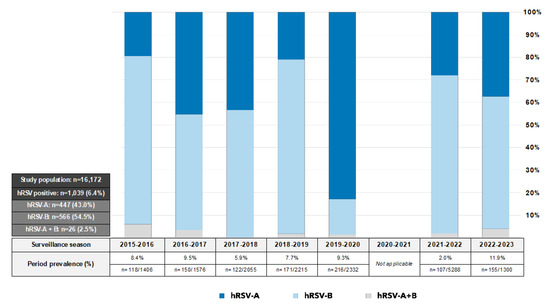
Figure 1

Journal Menu
► ▼ Journal Menu-
- Pathogens Home
- Aims & Scope
- Editorial Board
- Reviewer Board
- Topical Advisory Panel
- Instructions for Authors
- Special Issues
- Topics
- Sections & Collections
- Article Processing Charge
- Indexing & Archiving
- Editor’s Choice Articles
- Most Cited & Viewed
- Journal Statistics
- Journal History
- Journal Awards
- Conferences
- Editorial Office
Journal Browser
► ▼ Journal BrowserHighly Accessed Articles
Latest Books
E-Mail Alert
News
Topics
Topic in
Cells, Pathogens, Receptors, Vaccines, Viruses
Mucosal Immunity to Infectious Diseases
Topic Editors: Jay A. Berzofsky, Yongjun SuiDeadline: 30 September 2023
Topic in
Agronomy, JoF, Microorganisms, Pathogens, Plants
New Insights and Case Studies in Specific and Complex Plant Diseases
Topic Editors: Stefania Loreti, Massimo Pilotti, Marco Scortichini, Tatjana Popović MilovanovićDeadline: 30 November 2023
Topic in
Antibiotics, Biomedicines, Microorganisms, Parasitologia, Pathogens, Vaccines
Advances in Vaccines and Antimicrobial Therapy
Topic Editors: Roberto Paganelli, Raffaele D’AmelioDeadline: 30 December 2023
Topic in
Biologics, Biology, MPs, Pathogens, Vaccines
Global Analysis of SARS-CoV-2 Serology, Part 2
Topic Editors: Ger Rijkers, Jean-Luc MurkDeadline: 31 December 2023

Conferences
Special Issues
Special Issue in
Pathogens
Epidemiology, Evolution, and Prevention of Animal Coronaviruses
Guest Editor: Jingfei WangDeadline: 1 September 2023
Special Issue in
Pathogens
Staphylococcus Infections in Humans and Animals
Guest Editor: Jilei ZhangDeadline: 15 September 2023
Special Issue in
Pathogens
Prevention and Management of Tree Diseases
Guest Editors: Paolo Gonthier, Matteo GarbelottoDeadline: 30 September 2023
Special Issue in
Pathogens
Highly Pathogenic Viruses: Challenges for Diagnostics Development and Drug Discovery
Guest Editors: Cristiano Salata, Ilaria FrassonDeadline: 20 October 2023
Topical Collections
Topical Collection in
Pathogens
Mastitis in Dairy Ruminants
Collection Editors: George Fthenakis, Maria Filippa Addis
Topical Collection in
Pathogens
Feature Papers on Parasitic Pathogens
Collection Editor: Sébastien Besteiro
Topical Collection in
Pathogens
SARS-CoV-2 Replication and Pathogenesis
Collection Editors: Makoto Takeda, Wataru Kamitani
Topical Collection in
Pathogens
Emerging and Re-emerging Pathogens
Collection Editors: Sheng-Fan Wang, Wen-Hung Wang, Arunee Thitithanyanont




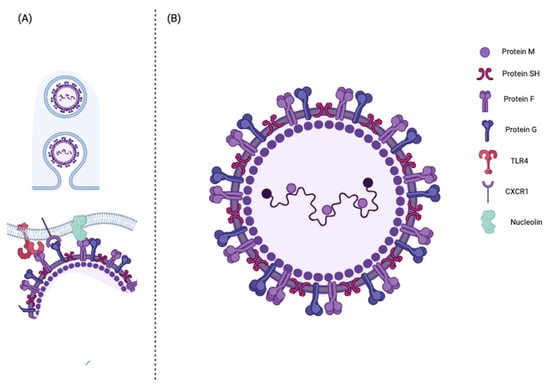






.JPG)











